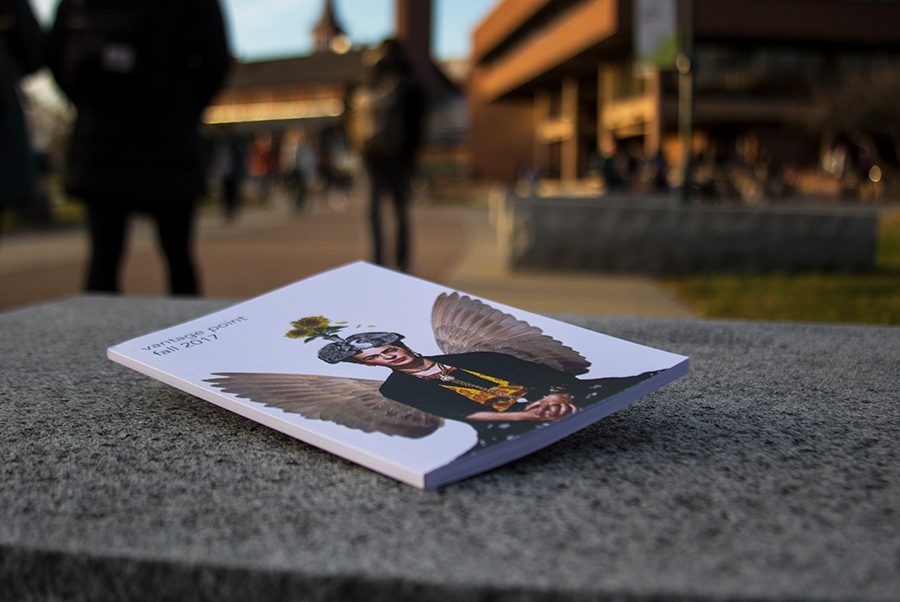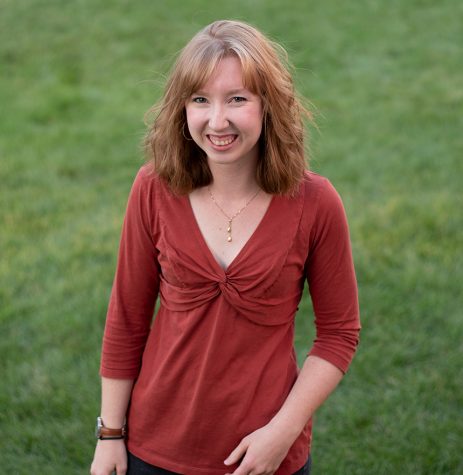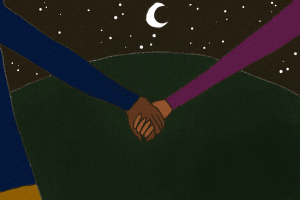Student-run literary magazine feels it deserves better
The newest edition of the UVM student-run literary arts magazine, Vantage Point Nov. 15. The publication is almost 20 years old and accepts student art of all kinds, ranging from short fiction writing to photography.
November 29, 2017
As students stress in libraries to finish papers and study for exams, some celebrate the publication of their creative work in a nearly 20 year-old student-run magazine.
Vantage Point is UVM’s student-run literary arts magazine that accepts student art submissions of all kinds throughout each semester. Everything from color photos, collages and paintings, to poems and short stories are welcomed.
The fall 2017 edition of Vantage Point is a cross section of UVM’s creative scene, according to Prof. Stephen Cramer, the magazine’s faculty advisor.
“I’m particularly excited by the editors’ decision to include short fiction, which has not been featured in Vantage Point for years,” Cramer said.
The Vantage Point staff huddles together, seated in the rickety desks of Old Mill A200 on Thursday nights at 7:30, to read, look at, and discuss all of the latest submissions.
The team votes to determine which submissions will appear in the published magazine. All of the submissions are reviewed anonymously, so that the identity of the writer or artist does not impact the decisions, Vantage Point’s co-editor Ali Wood said.
Wood has been co-editor of the magazine with senior Caroline Shea for five semesters.
Junior Dominique Boccanfuso’s digital collage depicting Frida Kahlo was chosen for the cover of the fall 2017 edition.
“[Frida] is an incredible artist and feminist icon. She has created beautiful, genuine, raw, intense works of art, which is why I incorporated the flowers growing out of her brain. You can interpret that further however you’d like,” Boccanfuso said.
She has been collaging since she was a kid, but is just now beginning to pursue art more seriously.
“I was previously taught that if you can’t draw or paint you are not an artist,” she said. “But professor Cami Davis’ class Perspectives on Art Making broadened my idea of what art can be,” Boccanfuso said.
“I have to admit that I get a lot of satisfaction seeing work that was created in my classes eventually show up in the journal. It’s gratifying to know that so many more people will happen upon the work than, say, the other 17 people in a creative writing class,” Cramer said.
But Wood believes Vantage Point deserves still more attention than it gets.
Vantage Point currently prints 400 copies of the magazine per semester. In order to print more and expand the readership, the group would either need to be given a bigger budget, or compromise the physical quality of the publication, she said.
“Vantage Point needs a stronger presence on campus,” Boccanfuso said. “I would be even more excited to be published in it, if I knew people were going to read it.”
She also believes the lack of funding for Vantage Point is part of a bigger issue of decreased appreciation for the arts across the university.
“The art department here helped me to see my potential as an artist, and it would be a shame if others weren’t able to see theirs too,” Boccanfuso said.
Cramer, whose approach to advising Vantage Point is pretty hands-off, makes a case for the importance of creative writing and the arts.
People who have difficulties in their careers after graduation struggle because they don’t understand their boss, their coworkers, their clients. It is a failure of the imagination, he said.
“Creative writing allows you to step into the skin of another person, to see the world from another point of view. And this helps no matter what field you eventually enter,” Cramer said.








